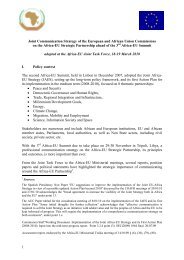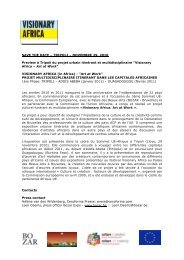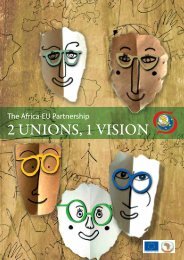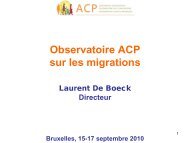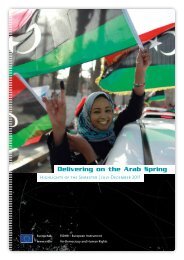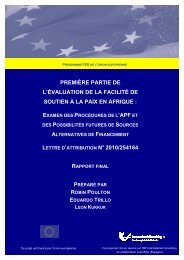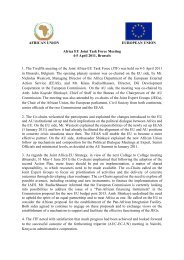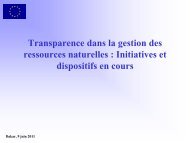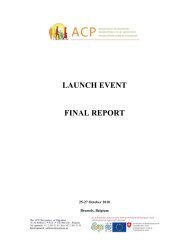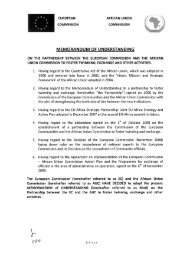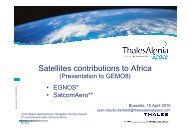part 1 of the african peace facility evaluation - European ...
part 1 of the african peace facility evaluation - European ...
part 1 of the african peace facility evaluation - European ...
You also want an ePaper? Increase the reach of your titles
YUMPU automatically turns print PDFs into web optimized ePapers that Google loves.
II.<br />
GENERAL APPRAISAL OF THE APF<br />
II.1 THE SUCCESS OF THE APF<br />
The APF is considered successful by most stakeholders, <strong>part</strong>icularly in funding PSOs and establishing<br />
<strong>the</strong> AU as a serious player in <strong>peace</strong> and security issues. Its action is rooted in repeated joint<br />
commitments by EU and AU to work toge<strong>the</strong>r for <strong>peace</strong> in Africa, based on a legal foundation<br />
especially Cotonou Art. 11. The APF has given <strong>the</strong> African Union political clout, with a physical and<br />
political presence in <strong>peace</strong>keeping that could not have been imagined ten years ago. The AU is now a<br />
functioning organisation with major military operations, some additional experience in police and<br />
civilian <strong>peace</strong>keeping and mediation, and significant budgetary experience. The APF has certainly<br />
achieved <strong>the</strong> objective <strong>of</strong> enhancing dialogue, but its achievements will be even more significant when<br />
all <strong>the</strong> pillars <strong>of</strong> APSA are fully functioning. 13<br />
The APF start was considered with great excitement in Europe, but even more so in Africa where AU<br />
MS governments were delighted with <strong>the</strong> idea that <strong>the</strong>y were contributing a ‘slice’ from <strong>the</strong>ir National<br />
Indicative Programmes (NIP) to build <strong>the</strong> Peace and Security Architecture <strong>of</strong> AU. EU Commissioner<br />
Poul Nielsen and AU Commissioner Said Djinnit understood <strong>the</strong> political importance <strong>of</strong> <strong>the</strong> African<br />
‘buy-in’: African ownership felt real because 50% <strong>of</strong> <strong>the</strong> 1st APF came from African states.<br />
Through <strong>the</strong> APF, <strong>the</strong> EU has taken political initiatives that were not even envisaged ten years ago.<br />
This has positioned <strong>the</strong> EU as a major actor on <strong>the</strong> <strong>peace</strong> and security fields in Africa. The EU has<br />
supplanted many <strong>of</strong> <strong>the</strong> post-colonial and bilateral processes that dominated in <strong>the</strong> 1990s, which is<br />
both appreciated by <strong>the</strong> Africans and EU MS including some <strong>of</strong> <strong>the</strong> former colonial powers who<br />
appreciate <strong>the</strong> <strong>European</strong> filter on <strong>peace</strong> and security issues.<br />
The APF has also allowed <strong>the</strong> EU to experiment foreign policy initiatives and procedural mechanisms<br />
that had never been tried before. The EEAS has <strong>the</strong> opportunity to build on this basis in Africa and<br />
elsewhere, seeking synergies within ODA 14 funding: <strong>the</strong> APF is a seminal experiment with long-term<br />
ramifications we cannot even begin to imagine. In a remarkably short period, <strong>the</strong> APF has changed<br />
<strong>the</strong> face <strong>of</strong> <strong>peace</strong> and security in Africa.<br />
APF is an instrument that provides political leverage to <strong>the</strong> AU; but some <strong>of</strong> <strong>the</strong> initial drive has<br />
diminished as procedures sometimes took precedence over political innovation. While procedures and<br />
internal controls are important, rules and regulations evolving in Brussels do not easily match with <strong>the</strong><br />
principle <strong>of</strong> African ownership and <strong>the</strong> requirements <strong>of</strong> effective delivery and value for money. AU and<br />
REC absorptive (and management) capacities are already limited by <strong>the</strong> newness <strong>of</strong> <strong>the</strong>ir structures<br />
13 ‘In order to make <strong>the</strong> APSA work, it is crucial to elaborate a forward-looking action plan on capacity-building,<br />
including <strong>the</strong> elaboration <strong>of</strong> an innovative policy approach that looks at real African needs and provides<br />
predictable and sustainable resources.’ Pirozzi and Miranda 2010, p3<br />
14 The EU’s <strong>of</strong>ficial development assistance had a total value <strong>of</strong> €49 billion in 2009, nearly €100 per citizen which<br />
is considerably more than in <strong>the</strong> US and Japan. African countries receive €15 billion annually, <strong>the</strong> main share <strong>of</strong><br />
EU development assistance. <strong>European</strong> aid stands at 0.42% <strong>of</strong> gross national income (GNI), includes 3 <strong>of</strong> <strong>the</strong> 5<br />
largest donors in <strong>the</strong> world (UK, France and Germany) and four <strong>of</strong> <strong>the</strong> five countries that exceed <strong>the</strong> UN target <strong>of</strong><br />
0.7% <strong>of</strong> GNI being given to development aid (Sweden, Denmark, Ne<strong>the</strong>rlands, Luxembourg). However, <strong>the</strong> EU is<br />
not yet on its way to meet <strong>the</strong> 2015 ODA targets.<br />
http://www.deljpn.ec.europa.eu/modules/world/human/oda/<br />
Page 9 <strong>of</strong> 49




